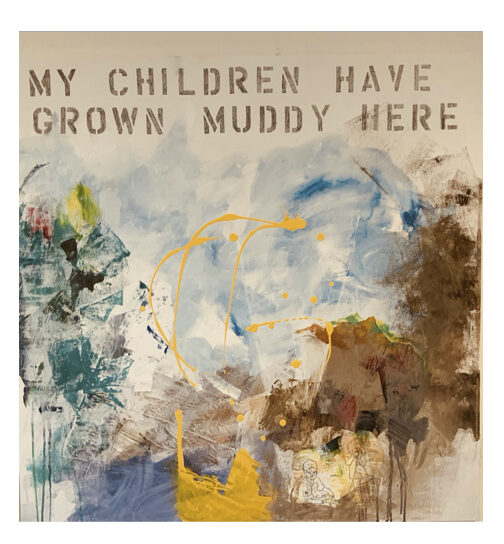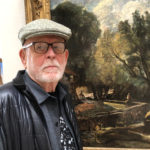Charles D. Tarlton
Cusp of Form

Ann Knickerbocker, My Children Have Grown Muddy Here
(Acrylic, pencil, collage on canvas, 36″ square, 2020)
I found I could say things with color and shapes that I couldn't say
any other way—things I had no words for.
— Georgia O'Keeffe
In paintings from the Italian Renaissance the “illusion” of objects under the brush is sustained by the persistence of color out to the farthest edge; the conventional boundary of the object fuses with the extent of the color, and vice versa. There are other styles of painting, Matisse comes to mind, in which the object and the color are often roughly outlined in black. Color is thus corralled by the “shape” of the object, a face, say, or a tree. In the painting here under consideration, color and object are indistinguishable. We might fail to make this observation because there are no “conventional” shapes or forms here, no boats or mountains. Or here, you might say, in a sense very different from paintings of familiar objects, the colors are the objects.
the first line of a poem distracted by the curving yellow spouts into the blue ought to have been about how things seem near and far in a painting
besmirched drawings of children not in the eye no much as sentiment but it’s not for long — layers of blue and silver foil draw the eye back into play
I’ve never heard of mud straining so hard to be something else, and failing because burnt umber attracts other colors in a pigmental gravity
It makes a kind of sense to imagine there might be other worlds so different from ours that the rules of physics would allow aberrations like the solidity of vaporous forms or permit slim washes of color to have a lack of illumination weighed in ounces and pounds, and shadows silhouetted in colors — blue, yellow, and red projected on the walls.
makes you think more than twice exactly what it is that makes a sky blue our eyes define it, sure around a landscape, fractured clouds by Constable, over the bridge at night
I sense a vista onto blue, the opening of some wrench or its closing, the jaw yawns. The comforting gray eyes still cling to the yellow in the bottom
so now you know, there is no real object, no specific conception expressed, no definite feeling I have in mind. It’s the energy, when you take the trees away
About the Author

Charles D. Tarlton is a retired professor who lives and writes (now) in Old Saybrook, Connecticut, with his wife, Ann Knickerbocker, an abstract painter.
